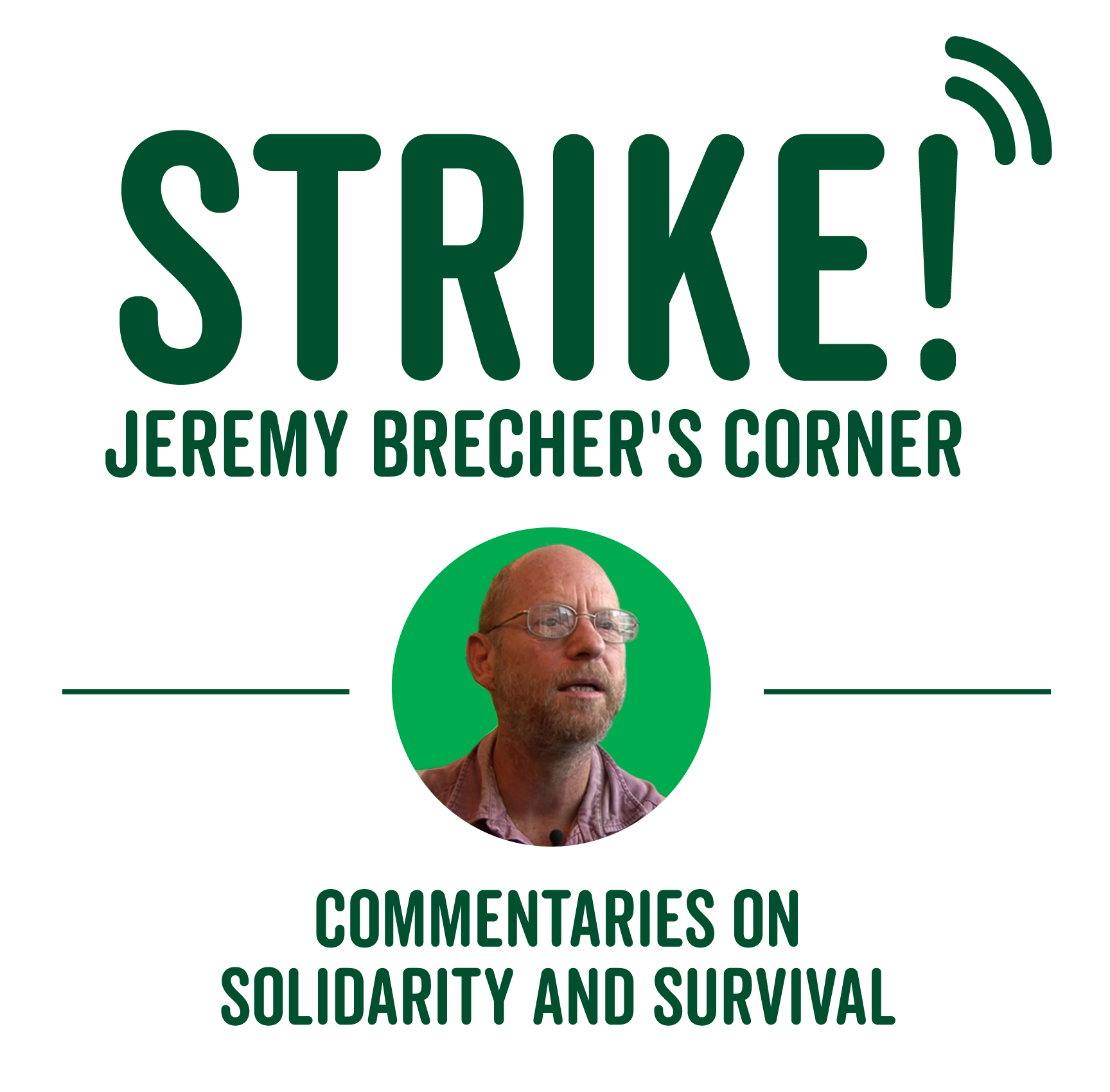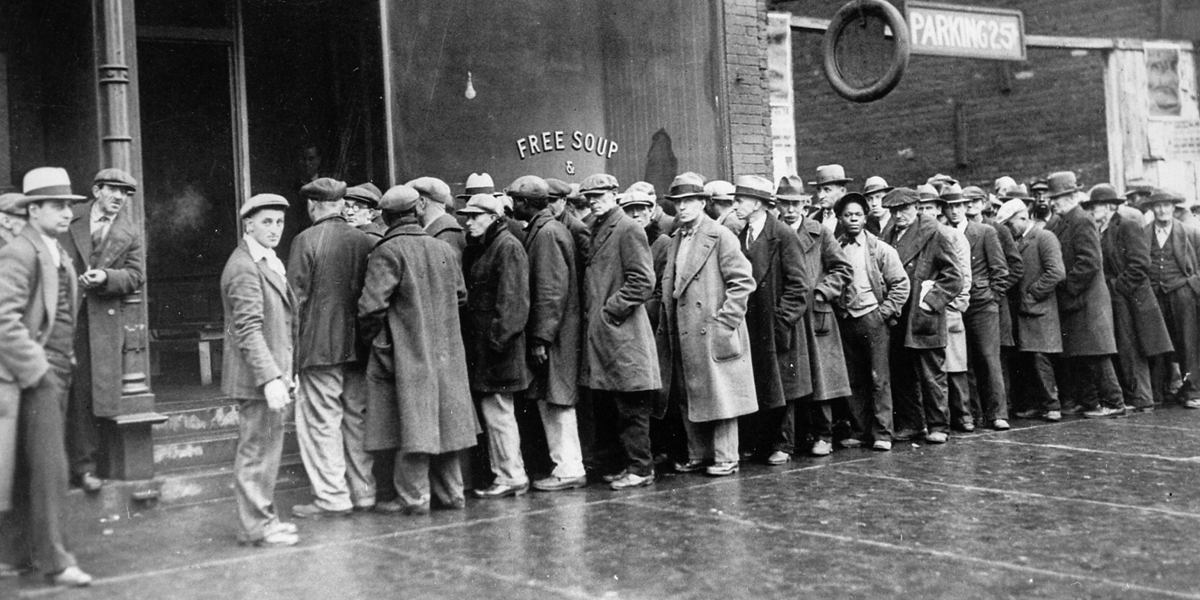
The United States has entered the deepest economic crisis since the Great Depression of the 1930s. This commentary describes the grassroots movements of the early years of the Great Depression in order to learn something about the dynamics of popular response to depression conditions. These early unemployed, self-help, labor, and other movements helped lay the groundwork for the New Deal and the massive labor struggles of the later 1930s. The next commentaries in this series will portray the grassroots movements of the Coronavirus Depression and ask what they might contribute to the emergence of a Green New Deal and a new labor movement. Subsequent commentaries will compare local and state actions in the early years of the Great Depression to such activities today. These commentaries are part of a series on the Emergency Green New Deal.[1] To listen to the audio version of this, click here.
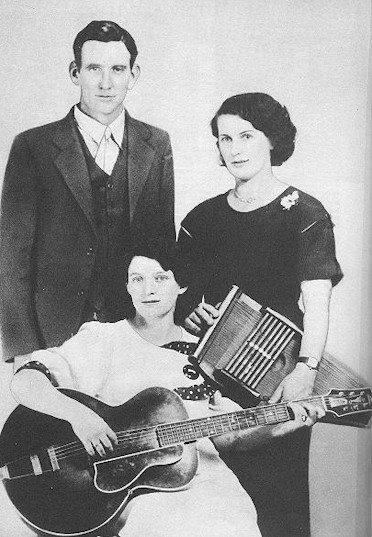
Carter Family promotional portrait by the Victor Talking Machine Company. Photo Credit: Wikimedia Commons, Victor Talking Machine Company
At the pit of the Great Depression in 1930, an American country music group called the Carter Family recorded a song called The Worried Man Blues. It began:
I went down to the river and I lay down to sleep
When I woke up there were shackles on my feet.
Though many subsequent verses describe the devastating cascade of events that followed for the singer, there is no explanation of what had happened or why – just an awakening to a seemingly endless litany of tribulations. The song immediately became an unprecedented national hit. It’s hard to believe that its success didn’t have something to do with capturing the sense of being the helpless victim of incomprehensible disaster that so many felt in the face of the Great Depression.
While the 1930s are sometimes portrayed as a time of revolt, the early years of the Great Depression were marked more by bewilderment and despair at what appeared to be an inexplicable catastrophe. But like today, there were also flickers of resistance, which not only helped people survive, but also built the momentum for greater changes to come. Both the similarities to and the differences from today’s Coronavirus Depression are revealing.
The Great Depression brought enormous misery—loss of jobs, homes, farms, savings, even the means to eat. Within three years, some fifteen million workers were unemployed. Yet the philosophy of most governments, articulated by President Herbert Hoover, was that the unemployed should take care of themselves, or if absolutely necessary receive assistance from private charities, not from government, and certainly not from the federal government.
Misery and hunger unabated generated new forms of revolt. By early 1932, according to a New York journalist, groups of thirty or forty men would enter grocery stores and ask for credit: “When the clerk tells them business is for cash only, they bid him stand aside; they don’t want to harm him, but they must have things to eat. They load up and depart.”
Labor writer Charles R. Walker observed and wrote about the movements of the early Great Depression. He prophesized “increasing outbursts of employed and unemployed alike—a kind of spontaneous democracy expressing itself in organized demonstrations” by large masses of people. “They will not be mobs—though the police will often break them up—but will march and meet in order, elect their own spokesmen and committees, and work out in detail their demands for work or relief.” They will “present their formulated needs to factory superintendents, relief commissions, and city councils, and to the government at Washington.”[2] That’s pretty much what happened.
Don’t Starve—Fight!
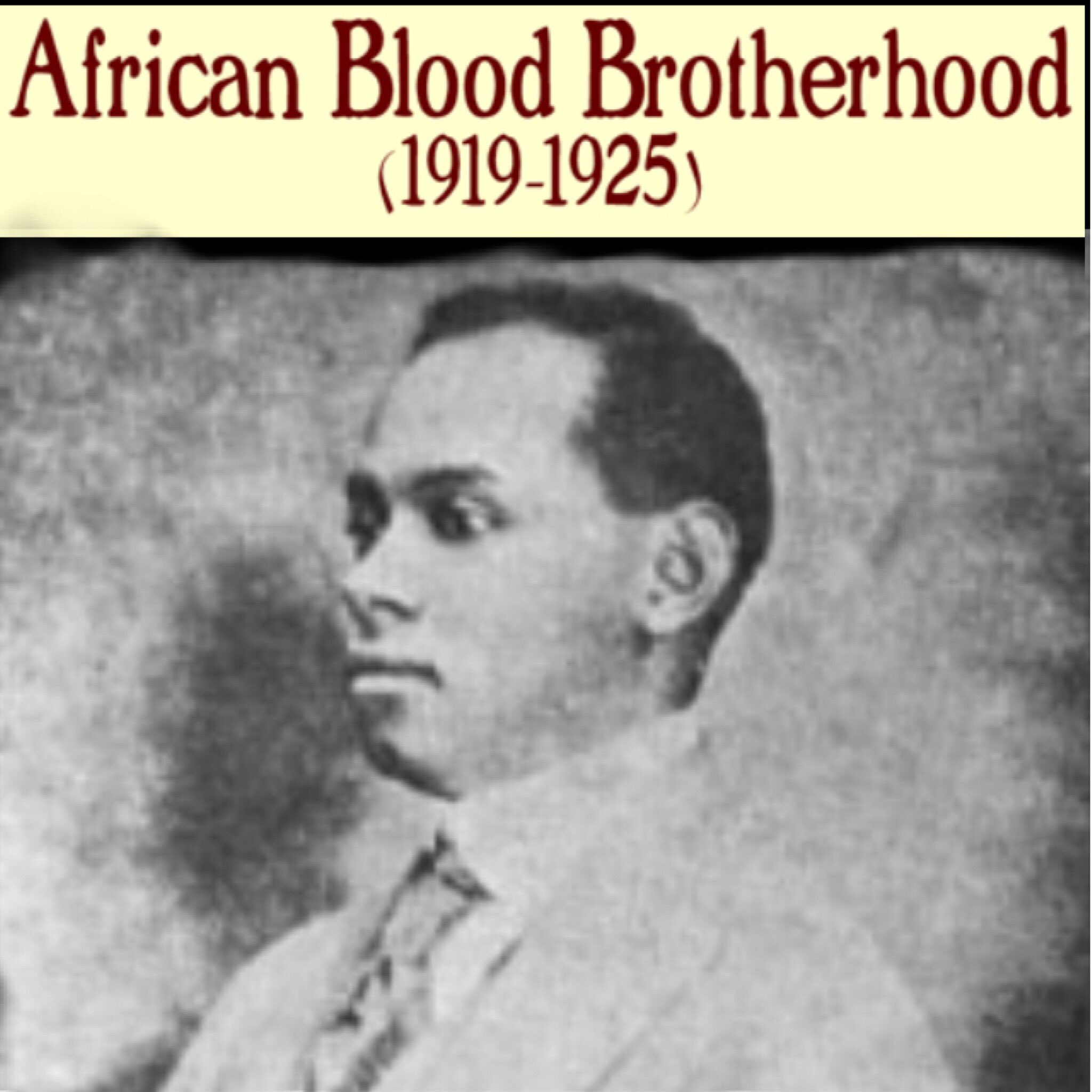
Pictured: Cyril Briggs
A prime example of the process Walker described were the Unemployed Councils and other movements of the unemployed.[3] Walker wrote, “the Unemployed Council is a democratic organ of the unemployed to secure by very practical means a control over their means of subsistence.” Communists organized Unemployed Councils in most cities and usually led them, but as Frances Fox Piven explains, “it wasn’t only communists; local religious leaders often became leaders of the unemployed, or leaders of the rural people who gathered to resist foreclosures of farms.”[4] According to Walker, “the councils are organized democratically and the majority rules.” In Lincoln Park, Michigan, the chairman of the Council was also the local commander of the American Legion.
In Chicago there were forty-five branches of the Unemployed Council, with a total membership of 22,000.
The Councils’ weapon is democratic force of numbers and their functions are: to prevent evictions of the destitute, or if evicted, to bring pressure to bear on the Relief Commission to find a new home for the evicted family; if an unemployed worker has his gas or his water turned off because he can’t pay for it, to investigate the case and demand their return from the proper authorities; to see that the unemployed who are shoeless and clothesless get both; to eliminate through publicity and pressure discriminations between Negroes and white persons, or against the foreign born, in matters of relief; for individuals or families and children of the unemployed who have no relief as a penalty for political views or have been denied it through neglect, lack of funds, or any other reasons whatever, to march them down to relief headquarters and demand they be fed and clothed. Finally, to provide legal defense for all unemployed arrested for joining parades, hunger marches, or attending union meetings.
Many unemployed councils were interracial and many Blacks participated in unemployed demonstrations. Black Communist leader Cyril Briggs described one demonstration as “the successful breaking down of the wall of prejudice between white and Negro workers fostered by the employers and the substitution of working-class solidarity and fraternization.” According to Black sociologists St. Clair Drake and Horace Cayton, Jr., “Here was something new” — “Negroes and whites together rioting against the forces of law and order.”[5]
The unemployed also took part in local and national marches and demonstrations, frequently demanding relief payments, public works jobs, and unemployment insurance and usually led by Communists; a national demonstration in 1930 claimed over a million participants. Many actions of the unemployed were met by police violence, arrests, and sometimes deadly shooting. An American Civil Liberties Union pamphlet reported, “Bans against assembly, refusal of permits to speak, the stationing of squads of police at relief stations, attacks by the police on peaceful meetings, clubbings, arrests, abuse of prisoners, infliction of maximum sentences, prosecution for criminal syndicalism or conspiracy” were “monotonously familiar.”[6]
The unemployed movement often supported the strikes of employed workers. The actions of the unemployed forced state and municipal governments to expand relief programs and, when they went broke, led the federal government to start paying for them. With the coming of the New Deal, the Councils transformed themselves into the Workers Alliance, a quasi-union for workers in the Works Progress Administration (WPA) and other federal public works programs. The Workers Alliance developed its own proposals for social security legislation and in 1936-7 held extensive protests that helped preserve Social Security from gutting by Congressional conservatives. When jobs opened up in the factories, many of its members became rank-and-file activists in the union organizing campaigns of the mid-1930s.
Self-help and mutual aid
In many places the unemployed also made attempts to organize economic life on their own outside the cash economy. In Seattle, for example, members of the Unemployed Citizens’ League were loaned fishing boats by the fishermen’s union, allowed to pick unmarketable fruits and vegetables by nearby farmers, and permitted to cut wood on scrub timberland. Members throughout the city organized twenty-two locals, each with its own commissary at which the food and firewood thus acquired was exchanged with barbers who cut hair, seamstresses who mended clothes, carpenters who repaired houses, and doctors who treated the sick. According to a massive study by Clark Kerr, by the end of 1932 there were 330 such self-help mutual aid organizations in thirty-seven states with membership over 300,000. But by early 1933, most of them, including the Seattle Unemployed Citizens’ League, were in disarray, as they began to discover the limitations of a self-help movement living off the scraps of an already collapsed economy.[7]
“We ain’t going to stand for no more bad treatment”
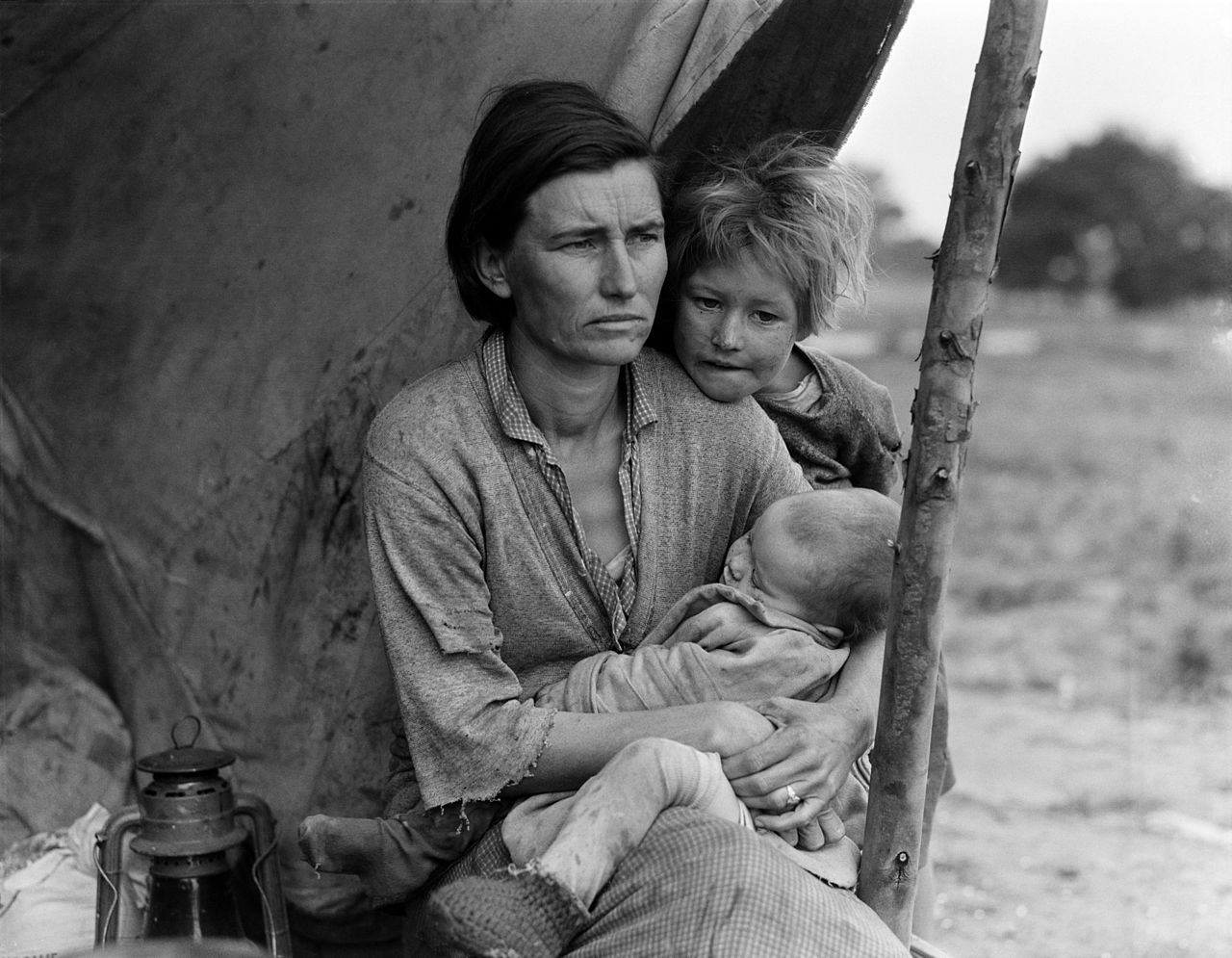
Migrant agricultural worker’s family. Seven hungry children. Mother aged thirty-two. Father is a native Californian. Destitute in pea picker’s camp, Nipomo, California, because of the failure of the early pea crop. These people had just sold their tent in order to buy food. Of the twenty-five hundred people in this camp most of them were destitute. Photo Credit: Wikimedia Commons, Dorothea Lange.
Although trade union strikes were rare and usually ineffectual during the early years of the Great Depression, employed workers nonetheless organized themselves, protested, and struck. For example, in High Point, North Carolina a few hundred stocking boarders walked out at six hosiery mills one July morning in 1932 when the second wage cut of the year was posted at their mills. Other hosiery workers joined and by the end of the day 1,600 had walked out. The next day bands of strikers and unemployed workers marched through High Point and nearby towns, closing 100 factories of all kinds employing 15,000 workers. The next day twenty-five unemployed workers forced their way into a High Point movie house and demanded admission, saying that they were out of work and entitled to entertainment. When the police drove them out, they wrecked a motor and turned off the town’s electricity, “to teach the big fellows that we ain’t going to stand for no more bad treatment.” The hosiery strike was finally settled through the intervention of the governor, with a revocation of the wage cut. Out of the conflict developed the Industrial Association of High Point, a union open to all industrial workers in the city, with 4,000 members and committees in each of the mills.
We Are All Leaders: The Alternative Unionism of the Early 1930s, edited by historian Staughton Lynd, has shown that such self-organized, community-based, “horizontal” forms of worker organization were widespread in the early years of the Great Depression. According to Lynd, they were “democratic, deeply rooted in mutual aid among workers of different crafts and work sites, and politically independent.” Their organizational form included “federal” labor unions directly affiliated with the American Federation of Labor, ad hoc factory committees, and “improvised central labor bodies” based on “horizontal networks.”[8]
What the “fight from below” accomplished
The unemployed, self-help, and strike movements of the early 1930s did not by any means halt or even significantly ameliorate the Great Depression. In fact, notwithstanding ups and downs of the business cycle, depression conditions continued until 1940 and the beginning of World War II. That doesn’t mean that these actions were pointless failures.
First, these movements often won immediate benefits for participants and other working people that ameliorated their misery and helped them to survive under depression conditions. Anti-eviction actions often restored families to their homes, and in Chicago and other cities they eventually forced governments to end evictions entirely. According to one estimate, “rent riots” restored 77,000 families in New York to their homes.[9] Charles R. Walker reported that in cities he visited the amount of relief was directly proportional to the strength and struggle of the local unemployed council. Hundreds of thousands of people made it through the worst years of the Great Depression through the barter and labor exchange activities of the mutual aid movement. The strikes of the early 1930s established a floor below which wages could not be cut without threat of resistance.
Second, these movements had significant impact on governments and other institutions. Direct action like hunger marches and occupations of government buildings put pressure on local, state, and at times even federal officials to establish relief and public works programs to replace private charity. With the coming of the New Deal in 1933 pressure from those states as well as from the unemployed themselves led federal government officials to take over and enormously expand provision for the unemployed. In 1933 Congress created the Federal Emergency Relief Administration and Civil Works Administration to provide relief payments and construction jobs; in 1935 it established the Works Progress Administration to create mass employment across occupations. As Frances Fox Piven says, “it was direct action that forced them to do it.” It was important to get that money out “to preserve order in the cities.” There are “archival records of local officials writing to Congressional committees” saying, “Send money now or troops later.” The unemployed movement and the fiscal pressure it put on local and state governments led “mayors, governors, social workers, and labor officials” to become “the lobbying arm of the unemployed workers movement” in the early 1930s.[10]
Third, the militant unemployed actions created what one federal official later called “A period of social danger.”[11] These “increasing outbursts of employed and unemployed alike” created a fear – or hope – of greater upheavals that might make fundamental social and economic changes irrepressible. They put both the legitimacy and the viability of the status quo into question. Such an atmosphere was essential in making possible the reforms of the New Deal.
Fourth, these movements played a critical role in developing the ideas, capacities, and networks that would help make subsequent movements possible. Staughton Lynd portrays the early “horizontal” unionism of the early years of the Great Depression as the predecessor to the 1934 wave of strikes and general strikes. The organizations of the unemployed radicalized and trained many of those who became rank-and-file activists in the great industrial union organizing campaigns of the later 1930s. As historian Roy Rosenzweig wrote, “to the extent that the unemployed movement fostered trade-union consciousness and helped break down barriers between black and white workers, it contributed importantly to the strength of the American working class.”[12]
While the self-help mutual aid movement petered out, the idea of economic reconstruction through government support to worker cooperatives was experimented with by the WPA and became the basis for Upton Sinclair’s wildly popular 1934 End Poverty in California (EPIC) campaign.
The early years of the Great Depression were marked by governmental indifference to colossal misery and the rise of corporatist and proto-fascist responses to it. The grassroots movements of workers and the unemployed formed a crucial part of the process that led instead to the emergence of the New Deal and the development of new and expanded forms of working-class organization.
[1] https://www.labor4sustainability.org/strike/
[2] For Walker quotes see Jeremy Brecher, Strike! (Oakland: PM Press, 2020) Chapter 5.
[3] For an extended account of the unemployed movements of the 1930s see Frances Fox Piven and Richard A. Cloward, Poor People’s Movements: Why They Succeed, How They Fail, Chapter 2 (New York: Random House, 1977). For another interpretation see Steve Valocci, “The Unemployed Workers Movement of the 1930s,” Social Problems, May 1990. See also Roy Rosenzweig, “Organizing the Unemployed: The Early Years of the Great Depression, 1929-1933.” https://www.jstor.org/stable/pdf/j.ctv6mtdnm.14.pdf?refreqid=excelsior%3A9554f5c9eb6bf451ff6ffaa8255dafc5
[4] “The Unemployed Fight Back: An Interview with Frances Fox Piven,” Organizing Upgrade, https://organizingupgrade.com/the-unemployed-fight-back-an-interview-with-francis-fox-piven/
[5] Roy Rosenzweig, p. 172.
[6] Roy Rosenzweig, pp. 183-4.
[7] Jeremy Brecher, Strike! (Oakland: PM Press, 2020) p. 153-4.
[8] Staughton Lynd, ed., We Are All Leaders (Urbana and Chicago: University of Illinois Press, 1996) p. 3.
[9] Piven and Cloward, p. 54.
[10] Steve Valocci, p. 196.
[11] Frances Perkins, The Roosevelt I Knew (New York: Viking, 1946) p. 175.
[12] Rosenzweig, p. 182.

